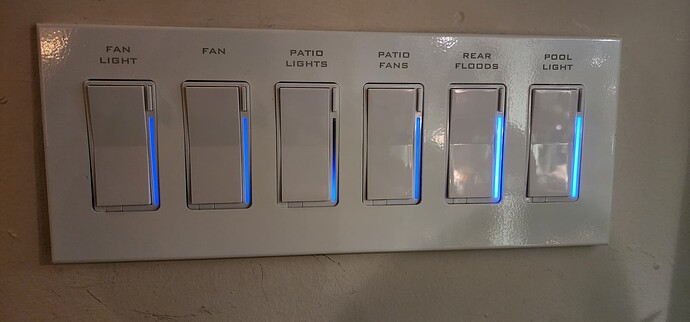These are all good points, and this is exactly why I posted this. I want to be challenged on this.
I get your point about “what if you only want one light on?” – and I’ve been thinking about that a lot and where that might be the case. First, judging by how we’ve been living in our current home, many of the rooms, like the living/dining rooms/kitchen, we always flip all of the lights on every time. In fact, we hardly ever flip them on, they just come on automatically at dusk. We have a few scenes set (a dimmer setting for evenings, for example that transitions on after sunset every night in all of the main rooms). Outside the automations, we have a “party” scene. And a “housekeeper” scene (extra bright white lights everywhere). But in years now, we’ve hardly ever touched or interrupted the automations.
But the kitchen is an exception. I sometimes DO want to adjust the brightness of the task lighting. So I’ve made sure I have some local switches in the kitchen that allow me to adjust the brightness. For example, we might have a dim kitchen when people are mingling at a party, but I might just want to turn up the sink or under cabinet lights to do last minute prep without turning on the default bright lights for the whole room. So we’ve put extra local switches there.
The other place I’ve made exceptions is vanity lights. You should be able to adjust those so I made those switches local. And guest room night stands.
And finally, if that’s not good enough for us, we can always use our voice to turn on/off lights. Or HomeKit on the phone. I realize that’s great just for us, but not guests. But I doubt guests will ever need to make those types of adjustments. But, in case, we’ll have tablets on every floor that can be removed from the walls to make individual adjustments. But in my experience, that’s pretty rare. We don’t run around our house adjust dimness and color values very often. Only when we get tired of our scenes or want a new one and then we make it once and save it.
I’m also considering other fun ways of adjusting individual lights. Like why not have small remotes right next to some of the lamps that we might want to adjust, like a reading light or something. I’ll figure that out when I move in.
And, yes, things like fans and shades all have their own switches!
I commend you on the neat and labeled switches. And I can imagine why you’d want individual adjustment on all of those. But I wonder if you really need a living room bank of switches labeled “Overhead lights, End Tables, Reading Light, Corner Lamp, Table Lamp” etc. You probably just want to push them all on. We have four switches in our dining room now. It’s always tap tap tap tap every time we want the lights on. I don’t even know which switch does what. I just want them all on.
I think a Lutron or Caseta system (or whatever comes in 20 years) will be a selling point for this house. I’ve been talking with a ton of people in the business and, while I’m nervous, I think this will work for us. And for future residents. We can easily install any matter of scene panels or whatever to control individual lights down the road in every room. Or we can go for one of the ready-made Lutron systems, which this will already be wired for.
Did you see the video someone posted above. Go to the 11:15 mark. This guy seems to be just powering a scene switch and he put all of his light switches in the closet. I downloaded his reflected ceiling plan and he just has scene switches in every room and it looks like one light circuit hooked up physically to a switch. https://youtu.be/xTpl7WYMkcA
Thanks again, for the input and feedback. I’m curious if any of this makes sense. But I also understand that something that might work for us might not work for you, and vice versa.
